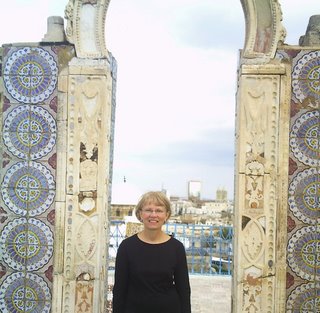Hammamet
 I’m staying in a hotel on one of the beautiful Tunisian beaches of fine, white sand–on the southwestern part of the peninsula of Cape Bon, near the city of Hammamet. The hotel has central heating, which is amazing since so many in Tunisia do not. I took a voiture de louage, i.e., a van that departs for its destination when it’s full. It was very cheap (4 Tunisian dinars or $3.00). On the trip, I visited with a Tunisian woman, who had worked for UNESCO in Paris and has traveled to the United States and other countries. She loves New York, she says. Her husband worked for the Ministry of Finance. They are now both retired. One son is a Tunisian pilot and studied in Denver. The other currently lives in Sydney, Australia. She once had an open-ended visa for the United States; but that has been canceled in recent years. She thought Tunisia was different among North African states because its people have a European mentality. She also think Tunisia has good wines, so maybe I should explore that area a bit more. Since Cape Bon is known as the cradle of Tunisian viticulture, some good wines are no doubt produced here. Cultivation of grapes for winemaking has a history going back to the Phoenicians and continued under the Carthaginians and Romans. Cape Bon is also known for its cultivation of orange and lemon trees, not to mention roses and jasmine. The lemonade upon arrival was delicious–cold, a conspicuous lemon taste but not acidic, and not too much sugar.
I’m staying in a hotel on one of the beautiful Tunisian beaches of fine, white sand–on the southwestern part of the peninsula of Cape Bon, near the city of Hammamet. The hotel has central heating, which is amazing since so many in Tunisia do not. I took a voiture de louage, i.e., a van that departs for its destination when it’s full. It was very cheap (4 Tunisian dinars or $3.00). On the trip, I visited with a Tunisian woman, who had worked for UNESCO in Paris and has traveled to the United States and other countries. She loves New York, she says. Her husband worked for the Ministry of Finance. They are now both retired. One son is a Tunisian pilot and studied in Denver. The other currently lives in Sydney, Australia. She once had an open-ended visa for the United States; but that has been canceled in recent years. She thought Tunisia was different among North African states because its people have a European mentality. She also think Tunisia has good wines, so maybe I should explore that area a bit more. Since Cape Bon is known as the cradle of Tunisian viticulture, some good wines are no doubt produced here. Cultivation of grapes for winemaking has a history going back to the Phoenicians and continued under the Carthaginians and Romans. Cape Bon is also known for its cultivation of orange and lemon trees, not to mention roses and jasmine. The lemonade upon arrival was delicious–cold, a conspicuous lemon taste but not acidic, and not too much sugar.Hammamet is a popular tourist destination. However, this time of year is great. The weather is cooler but still nice; and few people are here. Aside from a few jet skis on the Mediterranean, sunshine, the sea, and an air of tranquility prevail. Once a small fishing village, Hammamet today welcomes celebrities and sun-worshipers from around the world. In the 1930s, an Italian, Georges Sebastian, discovered Hammamet and built a neo-Moorish villa, decorated inAndalusian-art deco style. Frank Lloyd Wright said that it was the most beautiful house he knew of. Requisitioned by Rommel in 1943, it’s now a cultural center. The city does have a citadel and medina, which I plan to visit. Supposedly, the merchants are among the most insistent and strident in Tunisia. A guidebook suggests that visitors take it as part of the local folklore. If I don’t end up parting with any or too much money, maybe I can leave with that perspective. Their main goal is probably getting the most out of prosperous European tourists.
The lapping waves, washing in small stones worn smooth, the ripples of the sea at farther view, indefatigable currents closer at hand, the warmth of the sun on my face and skin, a refreshing breeze blowing back my hair, away from the crowds and bustle of the large city, I relaxed at ever deeper layers of sensation and muscle fiber and felt my mind had been swept clear of any problem or anxiety. My balcony with French doors (the room has a Tunisian style, rounded brick ceiling and white walls) opens out onto a garden with the sea in the background. I can hear the calls of birds (so far doves, sparrows, and blackbirds-with yellow beaks and circles around the eyes), absent in the desert and large urban areas. The sound of activity in nature is strangely satisfying. The greenery shuts off the thatched umbrellas, beach lounge chairs, and the people in them. Still, if I wish company, I only have to go to breakfast, walk out onto the pool area or beach, or make an appearance for dinner.
On the way to breakfast, the blue gray clouds of a Tunisian winter day were being warmed by the morning sun, seen in an uncluttered sky with only palm trees (some heavy with unripe bundles of deglet noor dates), hibiscus, and other flora for backdrop. At dusk, the scent of lilacs refreshes the path to dinner. The sunsets (couchers de soleil) are gorgeous; maybe it's the clear air with a distant mountain backdrop. Unlike Muslims, I didn’t need virgins to make this seem like paradise.


0 Comments:
Post a Comment
<< Home